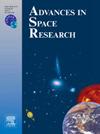Numerical simulation of mass and heat transfer for water extraction from icy lunar regolith
IF 2.8
3区 地球科学
Q2 ASTRONOMY & ASTROPHYSICS
引用次数: 0
Abstract
The confirmation of water ice’s existence in the permanent shadow area led to extensive research in the field of water ice mining from icy lunar regolith. A priori numerical simulation of water ice mining is necessary for guiding the development of lunar water ice mining schemes more reasonably. A 2D axisymmetric numerical simulation model capable of simulating the thermal extraction process about mining water ice from icy lunar regolith is constructed, which is executed in the COMSOL Multiphysics. The thermal extraction cases of lunar regolith with different initial water ice content and heating fluxes are simulated. The EER (energy efficiency ratio) is used to evaluate the efficiency of thermal extraction. The results show that the EER is higher as the initial water ice content is increased, which means more power is used to heat water and less power is used to heat the regolith. The icy lunar regolith with initial water ice content higher than 5.0 wt% is found to be more valuable, over which the EER at the end of thermal extraction will not increase much as the initial water ice content increases. However, the higher heating flux leads to the lower EER at the end of thermal extraction. The speed and economics of thermal extraction are suggested to be weighted before the mission’s implementation. The status of thermal diffusion (thermal transpiration) is studied, and the results indicate that thermal diffusion and advection both can be ignored in thermal extraction modeling, unless the average magnitude of temperature gradient and pressure gradient exceed the maximum of 75764 K/m and 11053 Pa/m in our calculation cases, respectively.
从冰质月球岩石中提取水的传质和传热数值模拟
本文章由计算机程序翻译,如有差异,请以英文原文为准。
求助全文
约1分钟内获得全文
求助全文
来源期刊

Advances in Space Research
地学天文-地球科学综合
CiteScore
5.20
自引率
11.50%
发文量
800
审稿时长
5.8 months
期刊介绍:
The COSPAR publication Advances in Space Research (ASR) is an open journal covering all areas of space research including: space studies of the Earth''s surface, meteorology, climate, the Earth-Moon system, planets and small bodies of the solar system, upper atmospheres, ionospheres and magnetospheres of the Earth and planets including reference atmospheres, space plasmas in the solar system, astrophysics from space, materials sciences in space, fundamental physics in space, space debris, space weather, Earth observations of space phenomena, etc.
NB: Please note that manuscripts related to life sciences as related to space are no more accepted for submission to Advances in Space Research. Such manuscripts should now be submitted to the new COSPAR Journal Life Sciences in Space Research (LSSR).
All submissions are reviewed by two scientists in the field. COSPAR is an interdisciplinary scientific organization concerned with the progress of space research on an international scale. Operating under the rules of ICSU, COSPAR ignores political considerations and considers all questions solely from the scientific viewpoint.
 求助内容:
求助内容: 应助结果提醒方式:
应助结果提醒方式:


